|
JULY 2020
|
|

|
This month, Ancient Hixtory profiles John F. Heitz, who bought land
in
Hicksville
in 1850. He was not the
first German immigrant to settle in the village, but he may have been
the one whose generosity had the most beneficial and enduring impact.
Hicksville
had its first start in the
latter 1830s. Anyone who
stood at the depot in those days and looked around would have seen a
couple of railroad sheds, some appurtenant storage buildings, a cluster
of structures erected by people from
Jericho
, and a hotel. This was the
nucleus around which a thriving village might have grown - except that
one day a fire burned everything but the hotel to the ground.
It was a significant setback.
In 1849, settlement got its first real thrust.
A man named Frederick Heyne purchased 1,000 acres of land, hoping
that he could persuade a number of his fellow German immigrants to come
to Hicksville, and start developing it into a prosperous village - and
that's just what he did. Within
a year, the first of them were planting their roots.
One of those who arrived in 1850 was Johann Heitz, an unassuming
watchmaker.
In
about 1818, Johann Friedrich Heitz was born in the
Kingdom
of
Hanover
(today, his birthplace lies in the German state of
Lower Saxony
). Obeying the wishes of his
father, as a youth he diligently studied to become a Lutheran minister.
He acquired an excellent education, and - as he neared his
seventeenth birthday - he also acquired something else: the
realization that he had no calling for the ministry.
Once he acknowledged that, he changed course, and decided to
become a watchmaker.
Young Johann was not one to make rash decisions.
After completing a four-year apprenticeship, he traveled across
Europe
, working at his new craft as he went, learning different techniques.
It was a well-planned entry into his chosen career, which is not
surprising. The demands of
making timepieces would appeal only to a man who was patient and
methodical - after all, one does not spend hours making each little
gear or ratchet without knowing in advance how they are to fit and
function together. When he
returned home from his journeyman travels and set up shop, Heitz was no
novice. He possessed a
well-rounded knowledge of his craft; he was skilled at it, and he was
self-confident.
In
the mid 1840s, like a great many others in the German states of Europe,
several members of his family decided to emigrate across the Atlantic,
and Johann was one of them. He
faced the change of country and culture as he had faced his earlier
change of career, not permitting himself to recklessly rush ahead.
Once in
New York
, he realized the importance of learning about the new milieu, and of
learning the English language, before making any crucial decisions.
Rather than immediately becoming a watchmaker, Heitz chose to
first be a common day laborer, so that he could learn English more
quickly by being among the people, and also so that he could learn about
New York
and the opportunities it offered.
Only when he learned enough did he set himself up as a watchmaker.
He is first listed in
New York
's city directory in 1848, both doing business at and residing on
Manhattan
's
Rector Street
.
|
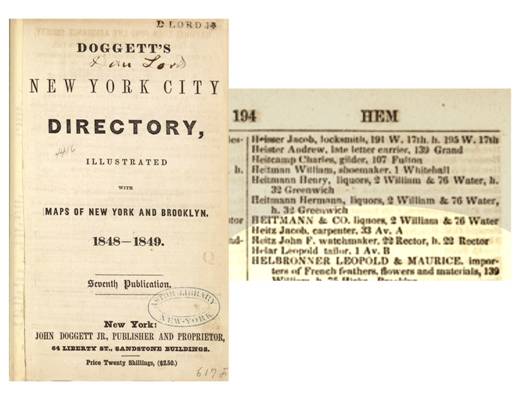
|
|
Listing
for Johann - now John - F. Heitz in 1848-1849 NYC Directory
New
York
Public Library Digital Images
|
|
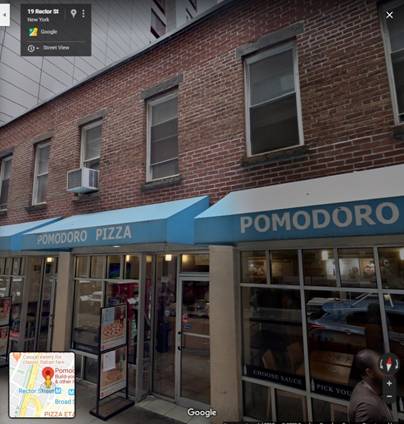
|
|
Heitz
lived first at
22 Rector Street
, and later at 20 Rector. The
buildings shown above, now consolidated, survive as 14 Rector.
20 Rector was either where the left-most upper windows can be
seen, or just to the left of them, where a new building rises.
Like
Pomodoro's, John Heitz's shop would have been at street
level.
Google
Street
View
|
Years
later, Heitz, wrote that from the beginning of his stay in
Manhattan
, he chose to create only good quality timepieces, even if that meant he
would make fewer sales. Sales
would not have been a problem at this location, however, for Wall Street
is only two blocks away. His
early explorations of the city had paid off - he chose a location that
was frequently seen by many of those who traded at the Stock Exchange.
The 1850 U.S. Census gives us further insight about Heitz's choice of
location. On the whole, the
neighborhood's inhabitants were neither poor nor affluent.
They worked at a variety of occupations: sailor, waiter,
merchant, sail-maker, tasselmaker (?), boatman, junk shop owner, barber,
watchmaker, "segar" maker, shoemaker, etc.
|
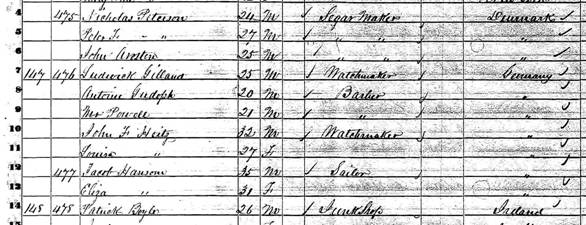
|
|
John
and his sister Louisa on the 1850
U.S.
Census
Ancestry.com
|
Living
quarters in the area were probably less lavish than those of the
watchmaker's clientele, but they would have been both convenient and
affordable. That suited John
Heitz, for he was industrious, thrifty, and patient.
He kept his eye on the future, and he lived inexpensively, in
order to retain more profits to invest in real estate.
Almost from the start, he began acquiring properties in
Manhattan
and
Brooklyn
.
The census also reveals
another thing. A second
German watchmaker, younger than Heitz, lived in the same residence.
He may have worked independently and simply shared the shop space
with Heitz, but I think it more likely that he was doing what John had
done in
Europe
- gaining knowledge, and deepening his skill set, by working for
someone who was more experienced. If
so, Heitz benefited from having an assistant, but the arrangement also
provided him with a way to "pay it forward" by helping a young
craftsman get a good start in life.
|
***
|
|
Gradual Transition to
Hicksville
|
Around 1850, only two
years after he was first listed in the city directory, John Heitz bought
his first property in
Hicksville
, and by the following year a home had been built on it.
Although he now was nominally a resident of the village, his
business was still in
Manhattan
. At the time, travel was
still too arduous for daily commuting to be feasible, and he maintained
a
Manhattan
residence as well. Eventually,
he had only a room in a boarding house there, in which a state-wide
census found him in 1855, and recorded him as a "jeweler."
Alas, the "good old days" were not necessarily perfect.
One night in 1859, a burglar broke into Heitz's shop and made
off with merchandise totaling (in 2020 dollars) almost $4,000.
As the thief was arrested promptly the next day, one can assume
that the stolen items were recovered.
|
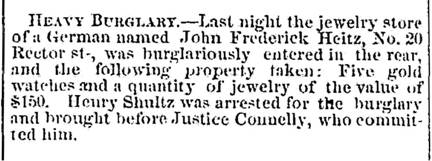
|
|
The
Brooklyn
Daily Eagle, July 27, 1859
|
In 1861, at the age of 43,
John Heitz married Jane Sutton Norris, an Irish-born woman almost twenty
years his junior. Within two
years, he had retired from his business and was living full-time in
Hicksville
with his new family. Thanks
to his investments, he continued to prosper, and to buy more local real
estate.
Although Heitz was quite active in the community, he missed running a
hands-on business. Thus, in
1869 he opened a dry goods and clothing store.
The next year's census showed the Heitz family living in
Hicksville
, but it was not alone - sharing the house with them was the family of
John's brother-in-law, William Sutton.
|
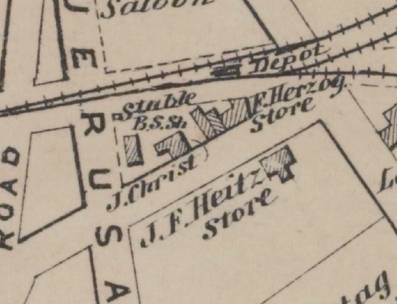
|
|
Location
of John F. Heitz's dry goods store
(across
Heitz Place
from the Herzog store)
Beers,
Comstock & Cline, Atlas of
Long Island
, etc., 1873
digitalcollections.nypl.org
|
|
***
|
|
"The Highest Type of Manhood"
|
While
Hicksville
still was young, John Heitz had begun planning for its future, much as
he planned for his own. The
village would need a real school - thus he donated land on
Nicholai Street
, and in 1853 the village's first true schoolhouse was built on it.
Around the same time, he donated a site on Broadway for the
construction of
Hicksville
's small Union Chapel.
After so many Germans had settled in the area that a Lutheran
church was warranted, he donated land for one - the village's first
denominational church building.
Early in his retirement from watchmaking, Heitz was disappointed to find
that he did not care for raising and tending crops, even as a gentleman
farmer. Nonetheless, he
loved the countryside and its flora.
Like E. H. de Languillette, he was both a founder of
Oyster Bay
's agricultural society, and frequently one of its ongoing elected
officers. So that
Hicksville
would grow into a lovely village, he laid out a number of its secondary
streets (sadly, from early on, many buildings on Broadway had been built
too close to the narrow, centuries-old route).
Streets like Cherry or Mary - today's
Marie Street
- were built wider than had been the norm, and they were lined by
trees and sidewalks. Many
decades later, when towns all over western Long Island vied to attract
commuters, the mature shade trees that lined
Hicksville
's downtown streets were praised by real estate brokers.
|
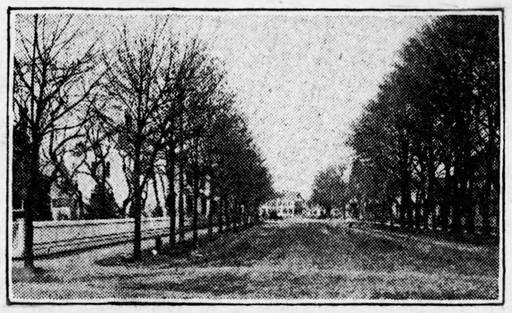
|
|
Marie Street
, c.1911
Brooklyn
Daily Eagle, September 3, 1911
|
John Heitz was the first
person in
Hicksville
to respond to the need for a community burial ground.
He donated land for what people liked to call the
Heitz Resting Place
. It later was incorporated,
and eventually was renamed Plain
Lawn Cemetery.
As long as he lived, Heitz continued
to turn his wealth into real estate.
When he died in 1881, it was said that no one owned more of the
village's land than he had.
Although he had been wealthy, he had not had an extravagant or elegant
lifestyle. The townspeople
remembered him as a friendly storekeeper, and they appreciated him as a
good man, who had done all he could to better
Hicksville
. Someone wrote that his
"life and precepts" had brightened the lives of all who knew him.
His peers at the Town of
Oyster Bay Agricultural Society wrote that he had been a man
"quiet and modest in his bearing, [who] fully exemplified the highest
type of manhood in his truthfulness, his integrity, his practical
charity to all."
Sources
Captions throughout the article indicate a number of
specific sources. Given the
years of Mr. Heitz's life, online images of old newspapers provided
less information than I had desired; only the Brooklyn
Daily Eagle proved useful. I
had expected the Huntington
Long-Islander to be a rich source, but I have yet to discover any
online issues earlier than the late 1880s.
As always, the impressive digital images available through the New York
Public Library were helpful, as were the collections at Ancestry.com.
My most useful source was the 1882 Munsell
History of Queens County, N.Y. Online,
I found a digitized version of a print copy in one of the
University
of
Toronto
's libraries - ironic; were it not for the pandemic, I could have
hopped on the subway and in twenty minutes been in the library, holding
the old tome in my hands. The
book's section about
Hicksville
, which includes brief biographies of Frederick Herzog and John F. Heitz,
was written by... John F. Heitz! He
died some months before the book was published; what he had written was
then edited to reflect his passing.
Incidentally, the portrait used at the start of this article
comes from that source.
I feel obligated to note a shortcoming of the Munsell History:
it had many contributors, who worked on different topics, each using
different sources as they saw fit. The
result is some inconsistency and inaccuracy, things which are especially
relevant if one reads about the founding of
Hicksville
.
My belief is that the combination of the disastrous early fire, and the
subsequent (but not immediate) resettlement by people from outside
Long Island
, created a vacuum of accurate local historical knowledge.
By the late 19th century, there was a consensus,
handed on from one person to the next, about what had happened in the
village before the Germans arrived - and in detail, it was at odds
with certain facts. Thus,
the History talks about
Jericho-based preacher Elias Hicks as the leader of the original
Hicksville
settlement, and it somewhat rearranges dates and events so that they fit
that premise.
Elsewhere in the same History is
a fact-based profile of Elias Hicks.
The famous Quaker could not have participated in the settlement
of
Hicksville
, which occurred (per the book) c.1836 - he had died some years
earlier, in February 1830.
That's that! And
now for something different....
|
*****
|
|

|
When
I wrote June's article, my research into its "main characters" was
less complete than I wanted. There
still were many unanswered questions about Madame Rosa, including the
location of the summer home from which her wannabe duelist
made his
escape. The following
relates how I connected a few dots and found some of those answers.
If you just want to see where in
Hicksville
she spent her summers, skip ahead to the map below.
If I was going to identify the location of Rosa's
house in
Hicksville
, I probably would need to know the name under which she owned it.
I was confident that her first name was Amy,
and that her middle initial was L.
Her birth surname was said to be Allison,
but the property might have been acquired using one of her husbands'
last names - if she was legally married to him.
With her having had so many husbands, whose names might
or might not have been stated accurately, I was not feeling very
optimistic. I decided to
start with her most recent married name, and to work backwards through
her earlier spouses' names only if necessary.
In an old New York State
Marriage Index, I found (despite someone's having indexed her as Anny,
rather than as Amy) an entry
for her marriage to Edward Stevens.
If she had kept her personal information on the county property
register up to date, it would show the owner as Amy
L. Stevens.
Of course, circumstances did not allow me to go to
Long Island
and check the county records; I was limited to using whatever online
references I could. Depending
on the sources that I accessed online, I would search for one or more of
the following people at any given time:
Amy L.
Stevens, aka Madame
Rosa
George Harper, her reputed
past husband / lover
Amy F. Harper, their
daughter
Using the name Amy
L. Stevens,
both with and without the middle initial, I searched old
New York
newspapers. One 'hit'
occurred in the Brooklyn Daily
Eagle of April 6, 1903: the report of the transfer of a property in
Hicksville
. The land in question was
described as adjoining property that was owned by Amy
Stevens. Of
additional interest was the name of the person who had sold the land: George
W. Harper. Was this the
same George Harper I was interested in
learning about? That was a
possibility, but I needed to find a way to confirm if that were true.
Daughter Amy
F. Harper had been born in the 1860s.
Unless her father had died soon afterward, he would have been
alive at the time of the 1870 U.S. Census.
I checked that census, and I found that it listed approximately
500 men named George Harper.
How could I figure out if any of them was the man who fathered Amy
F, and/or the man who would later sell the property in
Hicksville
? I was stymied.
As I puzzled over things, I went back and carefully
re-read everything I had ever seen about Mme. R, including items which I
had dismissed earlier because they seemed farfetched.
Eventually, I found an odd recurrence which I previously had
missed:
Louisiana
.
I now pondered the following items:
|
▪
|
In Rosa's testimony at the first Merrigan murder
trial, she talked about having discovered her clairvoyant
abilities while living in
New Orleans
, and about having since used those abilities for twelve years.
|
|
▪
|
According
to a census, her daughter Amy
F. Harper had been born in
Louisiana
in October of 1862 - the year to which
Rosa
alluded in 1874 when talking about events twelve years in the
past.
|
|
▪
|
Reviewing
data for all the George Harpers in
New York
, I found that only one of them reported having been born in
Louisiana
(I had missed that earlier, because he had reported this fact on
only one of the censuses for which he was enumerated).
This man resided in
Brooklyn
. His birth year was
around 1859; his birth month was August.
His name was George W. Harper.
|
So... there was a George
W. Harper of interest, too young to have been Rosa's lover, but
with the same name as her
Hicksville
neighbor. Could a document
from
Louisiana
, where he had been born, clarify whether this man was a new-found
relative of Rosa, or merely a stranger whose name was a coincidence?
I now worked my way through old records from
Louisiana
, where I eventually found something significant.
The Index of Births for New
Orleans, Louisiana told me that on August 15, 1860, Amy Allison, who had been born in
New York
State
, gave birth to a boy named George
Washington Harper. The
baby's father was George
M. Harper, born in
England
. Unpacking this information
led to these conclusions:
|
▪
|
Amy
Allison (aka Madame Rosa) was in
New Orleans
in 1860, giving birth.
|
|
▪
|
George M. Harper,
her baby's father, was the man to whom Edward Stevens feared
Rosa
would return.
|
|
▪
|
George M. Harper
was British, which fit with the information about Amy
F. Harper's father provided for the 1880 U.S.
Census.
|
|
▪
|
George W. Harper,
who sold the property in
Hicksville
, could be assumed to be the brother of Amy
F.
|
I found no entry in the Index of Births for Amy
F. Harper, but that made sense.
Unlike her apparent brother George
W. Harper, she was born during the Civil War.
During the pregnancy,
New Orleans
- the largest city in the Confederacy - was being attacked by, and
ultimately fell to, Union forces. Its
residents panicked. Once
Northern troops were able to establish order, every English resident,
including
George M. Harper, would be suspected of subverting the Union
cause. It is probable that,
like a great many others, he and his family fled the city during the
bombardment. If they did,
Rosa's being pregnant would have limited how far they could flee; they
may have found a haven further inland in Louisiana, and remained there
until baby Amy
F. was born.
|
***
|
|
The
Property in
Hicksville
|
I now believe that Madame Rosa, whether before her
death, or through her will (if a will ever existed), split her summer
estate in Hicksville equally between her two children, which explains
how her son George W. Harper
possessed a
Hicksville
property to sell in 1903.
In 1884, his sister Amy
F. married Edgar Latourette, an "oyster man" from
Staten Island
. By the early 1900s, their
family was living in
Hicksville
. As newspapers did in those
days, the
Hicksville
page of the Long-Islander would
report on even the tiniest item of social interest.
Thus, now and then readers would learn that Mrs.
Amy Latourette's Harper
nieces had come from
Brooklyn
for a visit. The reports
never mentioned Mme. Rosa.
The 1914 map below shows that the Latourette family resided on what then
was called Duffy's Lane, at
the intersection of
Morgan Avenue
. Amy
Latourette's property is highlighted.
|
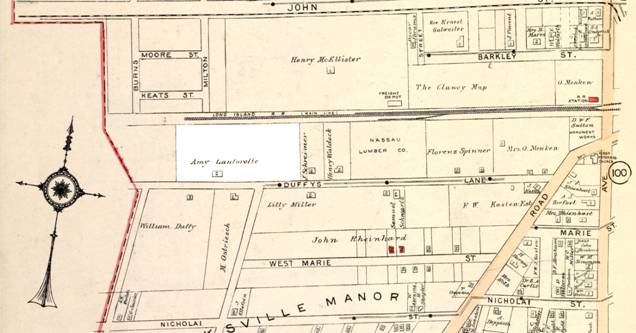
|
|
Back when the Duffy family lived on the "lane" to
which the village gave
their name, they could see Madame Rosa's summer estate across
the road.
To us, the idea of living up against the railroad's
right-of-way may
not be appealing. Bear
in mind that when the land was purchased
in the 1870s, trains were infrequent, and they did not run at
night.
1914 Belcher-Hyde Atlas of
Nassau
County
, pages 99 and 100 (excerpt)
https://digitalcollections.nypl.org/items/510d47e4-3ac2-a3d9-e040-e00a18064a99
|
If young Amy
F. owned only half of what her mother originally owned, then
Madame Rosa's property had indeed been large - rather remarkable a
summer property for someone who made her living on Canal Street as a
clairvoyant.
Amy F. Harper Latourette and her
family continued to reside in Hicksville for several years, but by 1920
they had moved to the Town of
Hempstead
, breaking the last thread that connected Madame Rosa and
Hicksville
. One wonders if anyone -
some old codger from Duffy's Lane, or perhaps Amy
F herself - ever told her children about their clairvoyant
grandmother, and about the scandalous duel that never took place.
That's all for this month.
Be Well!
|








